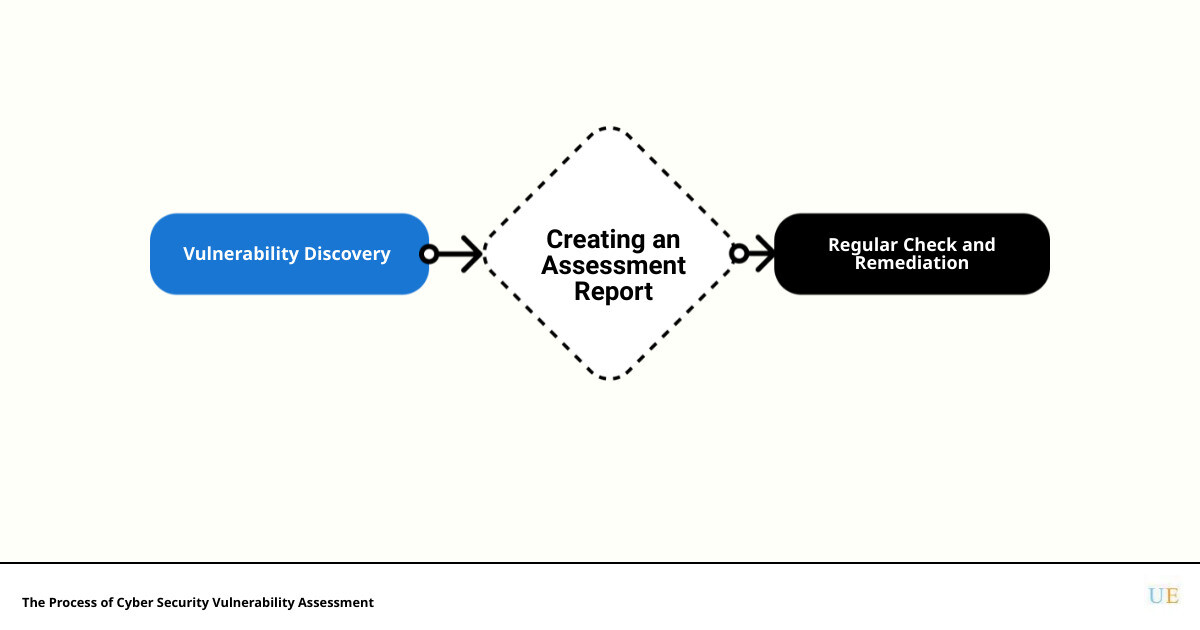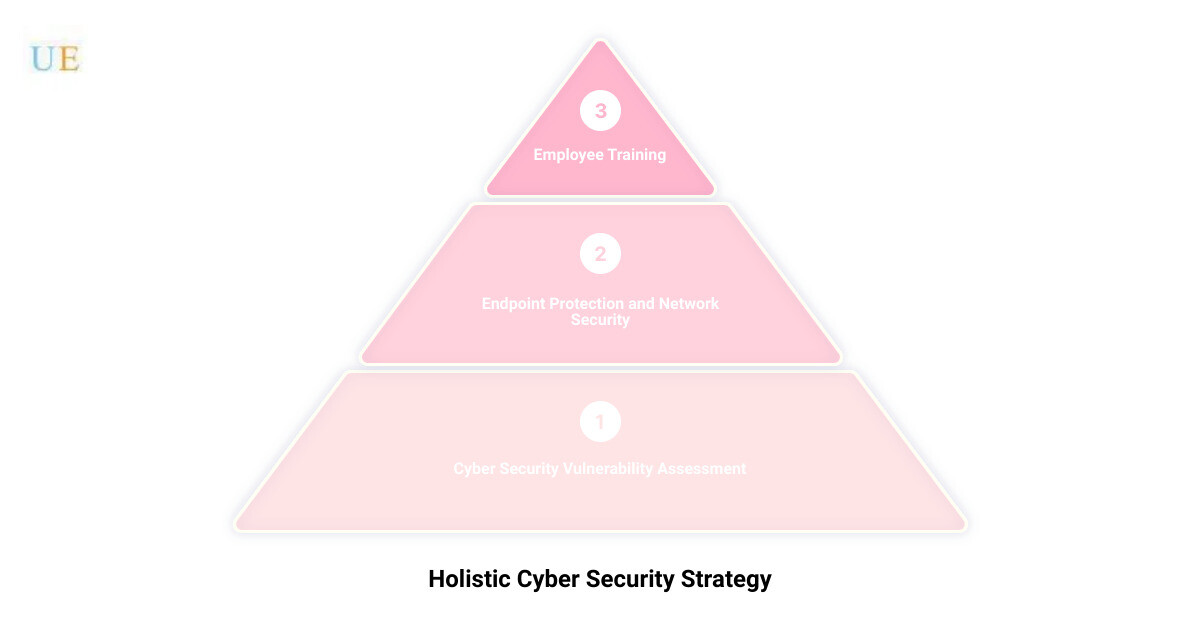In the constantly evolving world of cyberspace, the safety of your IT infrastructure rests on razor-thin margins. Even minor vulnerabilities can open large backdoors for hackers and cybercriminals, putting your organization at significant risk. A key component in strengthening IT armor, Cyber Security Vulnerability Assessments, lie at the epicenter of a secure digital landscape. This assessment is a powerful tool that safeguards your organization’s data, ensuring necessary precautions are in place to minimize potential threats. At Upper Echelon Technology Group, we are focused on helping businesses turn technology from a liability into an asset, and pivotal to this strategy is bolstering cyber security measures.
As business landscapes and technologies are dynamically advancing, so are the tactics employed by cybercriminals to exploit vulnerabilities. A proactive approach with a comprehensive vulnerability assessment can keep IT infrastructure robust and secure, saving not only resources and data breaches but the organization’s reputation itself.
Cyber Security Vulnerability Assessment Snapshot:
- Identification: Uncover weaknesses in IT infrastructures—networks, systems, hardware, applications.
- Analysis: Determine the risk level and impact of each identified vulnerability.
- Prioritization: Understand which threats require immediate attention based on their potential damage.
- Remediation Strategy: Plan the course of action for mitigating or removing identified threats.
- Compliance: Align the security standards to meet regulatory needs like HIPAA and PCI DSS.
Whether it’s protecting your organization against data breaches or meeting regulatory compliances, performing a vulnerability assessment is no longer an option, it’s an imperative. In this article, we at Upper Echelon Technology Group will delve deeper into the dynamic landscape of cyber security vulnerability assessments, exploring their significance, process, types, and how they can help protect your digital assets against emerging threats.
As we navigate this intricate labyrinth of cyber threats, let’s shed light on the deeper layers of the effective counter-strategies, setting your business on its road to cyber resilience.
Stay Excited! Stay Tuned! A thoroughly enlightening exploration of Cyber Security Vulnerability Assessments awaits you!
Understanding Cyber Security Vulnerability Assessments
To fortify your business against the evolving digital threats, it’s crucial to first understand the terrain you’re navigating. Cyber Security Vulnerability Assessments, an integral part of the cyber resilience framework, offer that exact insight.
Definition and Purpose of Cyber Security Vulnerability Assessments
A Cyber Security Vulnerability Assessment is a systematic examination of your information system or product. It’s a process to determine the adequacy of your security measures, identify security deficiencies, and provide data to predict the effectiveness of proposed security measures. Moreover, it validates the adequacy of such measures after their implementation.
At Upper Echelon Technology Group, we conduct these assessments to help businesses identify potential vulnerabilities in their networks, operating systems, and human and process elements. Our aim is to help you understand where your defenses might falter so that you can take proactive measures to strengthen them.
The Role of Cyber Security Vulnerability Assessments in Risk Management
In the grand scheme of risk management, Cyber Security Vulnerability Assessments play a pivotal role. They enable businesses to gauge their exposure to cyber threats and assess their sensitivity to these risks. By identifying potential vulnerabilities, businesses can prioritize their remediation efforts, focusing on areas with the highest risk first.
At Upper Echelon Technology Group, we understand that each business has a unique cyber risk profile. We tailor our assessments to align with the specific needs and potential threat vectors of your business, thereby enhancing your adaptive capacity to respond to cyber threats.
In essence, Cyber Security Vulnerability Assessments serve as a compass, guiding businesses in their journey towards cyber resilience. They are not just a one-time process but should be incorporated as a regular practice in your cyber risk management strategy.
With this understanding of the definition and role of Cyber Security Vulnerability Assessments, you’re now equipped to explore the process of conducting these assessments. Fasten your seatbelts as we delve deeper into this crucial aspect of cyber security.
The Process of Conducting a Cyber Security Vulnerability Assessment
In the complex world of cybersecurity, knowledge is power. The more we understand about potential vulnerabilities, the better we can protect our businesses. Now that we’ve established the importance of Cyber Security Vulnerability Assessment, let’s navigate through its step-by-step process.
Initial Preparation for the Assessment
The first stage of conducting a vulnerability assessment is akin to mapping out a journey before setting off. It involves identifying the assets that need protection and understanding their business value. We map out all the endpoints, determine the impact of potential attacks, and identify the security requirements of each system, noting any sensitive data and how it is transferred.
We also record a baseline of services, processes, and open ports on protected assets, along with the operating systems and software deployed. This step helps us understand the potential attack surfaces and develop a remediation strategy.
Testing and Analysis: Identifying Vulnerabilities
Automated vulnerability scans on the target devices and environments are run during this stage. Here at Upper Echelon Technology Group, we use various vulnerability databases, vendor security advisories, and threat intelligence feeds to make this stage efficient. The time taken for a single test can vary, but the result is a comprehensive understanding of the system’s security posture.
Prioritizing Vulnerabilities: From High to Low Risk
After identifying vulnerabilities, it’s essential to prioritize them. This involves eliminating false positives and ranking the vulnerabilities based on factors like the severity score, business impact, data at risk, ease of exploitation, duration of vulnerability, and the ability to move laterally to other sensitive systems.
Creating a Vulnerability Assessment Report: Documenting Findings
The next step is to create a unified report that details the vulnerabilities found in all protected assets, along with a plan for remediating them. For medium to high risk vulnerabilities, the report provides information about the vulnerability, when it was discovered, the potential damage if exploited, and the plan and effort required to remediate it. Ideally, a proof of concept demonstrating how each critical vulnerability could be exploited is also provided.
Continuous Vulnerability Assessment: The Need for Regular Checks
The cyber security landscape is not static. New vulnerabilities can emerge at any time, and attackers are continually evolving their tactics. That’s why continuous vulnerability assessment is crucial. Regular checks ensure that we stay updated on new threats and can take necessary actions promptly.
Cyber Security Vulnerability Assessment is not a one-time task but an ongoing process that requires constant vigilance. As we adapt to the dynamic landscape of cyber threats, regular assessments provide a robust shield of protection and peace of mind.
Types of Cyber Security Vulnerability Assessments
As we navigate the complex terrain of cyber threats, it’s essential to understand the different types of Cyber Security Vulnerability Assessments. Each type focuses on a specific area of your IT infrastructure, ensuring that every nook and cranny is scanned for vulnerabilities.
Network-based Scans: Protecting the Network Infrastructure
Network-based scans are the first line of defense in your cyber security strategy. These scans identify potential network security attacks by examining your network’s hardware and software. They can detect vulnerabilities that expose your network to potential intrusion from outside parties, allowing us at Upper Echelon Technology Group to take preventative measures before an attack occurs.
Host-based Scans: Securing Individual Systems
Host-based scans take a closer look at individual servers, workstations, and other network hosts. These scans identify vulnerable open ports and services, providing insights into the configuration settings and patch history of scanned systems. This granular approach to vulnerability assessment enables us to address weaknesses at the system level, reinforcing your security from the inside out.
Wireless Network Scans: Safeguarding Wireless Connections
Wi-Fi networks can be a weak point in your cyber defenses. Wireless network scans identify security weaknesses within your Wi-Fi network, including malicious access points. By ensuring your wireless networks are configured securely, we can prevent unauthorized access and protect your sensitive data.
Application Scans: Ensuring Application Security
Applications, both web-based and mobile, can contain software vulnerabilities and misconfigurations that expose your business to cyber threats. Application scans test websites and mobile applications for these vulnerabilities, enabling us to bolster your application security and keep your digital platforms safe.
Database Scans: Shielding Critical Data
Databases are often the primary target of cyber attacks as they often contain sensitive and valuable information. Database scans identify vulnerabilities that might allow database-specific attacks like SQL and NoSQL injection. By safeguarding your databases, we protect the heart of your business – your data.
As we conduct these various types of vulnerability assessments, our goal is always the same: to identify and mitigate potential threats before they can be exploited. By taking a proactive approach to cyber security, we can keep your business operating smoothly and securely in the face of ever-changing cyber threats.
Stay tuned as we dive deeper into common cyber security vulnerabilities and how to mitigate them in the next section.
Common Cyber Security Vulnerabilities and How to Mitigate Them
Pioneering the frontier of cyber security, we at Upper Echelon Technology Group are constantly on guard against a myriad of vulnerabilities. It’s a dynamic landscape that requires constant vigilance and expertise. In this section, we’ll delve into the most common types of cyber security vulnerabilities and offer strategies to mitigate them.
Network Vulnerabilities: Issues with Hardware and Software
Network vulnerabilities often stem from issues with a system’s hardware or software. These vulnerabilities can expose a network to potential intrusion by external parties. For instance, outdated software or improperly configured hardware can create gateways for cyber-attacks.
To mitigate these risks, we recommend routine network-based scans to identify potential weaknesses. Our managed IT services team can ensure that your network is protected and optimized 24/7, serving your business needs rather than becoming a liability.
Operating System Vulnerabilities: Weaknesses in the System
Operating systems, while integral to the functionality of your IT infrastructure, can also present a major point of vulnerability. These weaknesses may include outdated operating systems, missing patches, or improperly configured settings.
To combat these security risks, we employ host-based scans to safeguard individual systems. This includes ensuring all systems are updated with the latest security patches and configured according to best practices.
Human Vulnerabilities: The Role of User Behavior
Perhaps the most unpredictable of all are human vulnerabilities. These include behaviors such as using weak passwords, falling for phishing scams, or mismanaging sensitive information. As the saying goes, “the human factor is always the weakest link in the security chain.”
To address these issues, we provide comprehensive cyber security training resources to educate your team about safe online practices. In addition, our cybersecurity offering includes strategies to strengthen password security and increase overall user awareness.
Process Vulnerabilities: Problems in the Workflow
Last but not least, process vulnerabilities can pose significant risks. These are weaknesses that exist in business processes or workflows, such as inadequate access controls or lack of incident response planning.
To mitigate these vulnerabilities, we can help you implement robust processes that prioritize security. This includes establishing clear access controls, conducting regular audits, and crafting detailed incident response plans.
In conclusion, understanding and addressing these common vulnerabilities are crucial steps in fortifying your company’s cyber defenses. At Upper Echelon Technology Group, we are dedicated to providing you with comprehensive solutions to safeguard your business against these potential threats.
The Role of Vulnerability Assessment Tools in Cyber Security
In the ever-evolving landscape of cyber threats, staying a step ahead is vital for every business’s survival. Vulnerability assessment tools are an indispensable part of this process, as they allow us to identify, classify, and prioritize vulnerabilities in our network infrastructure, computer systems, and applications.
Automated Scanning for New and Existing Threats
Vulnerability assessment tools use automated scanning to identify potential security weaknesses. As highlighted by HackerOne, these tools are often deployed to scan an environment for vulnerabilities. They can detect issues ranging from outdated software and unsafe system configurations to weak passwords and potential malware infections.
Automated scanning is not just a one-time task but a continuous process. These tools regularly scan the system to identify new vulnerabilities that may have been introduced through updates, new components, or changes in the system configuration. This process helps ensure that no vulnerability goes unnoticed and that all potential threats are addressed promptly and effectively.
The Benefits of Regular, Automated Scans of IT Systems
Regular and automated scans of IT systems bring several benefits to the table. They allow us to identify and fix security weaknesses before they can be exploited by cybercriminals. This proactive approach significantly reduces the risk of data breaches and other cyber threats.
Moreover, automated scanning saves time and resources, as it eliminates the need for manual checks. It also provides us with a comprehensive vulnerability assessment report, offering detailed insights into the security status of our IT systems.
Finally, regular scans ensure that our security posture remains robust and up-to-date, even as new vulnerabilities and threats emerge.
Case Study: How Upper Echelon Technology Group LLC Uses Vulnerability Assessment Tools
At Upper Echelon Technology Group, we take cyber security seriously. We realize that the best defense is a good offense. Hence, we use vulnerability assessment tools as part of our proactive approach to cyber security.
We leverage these tools to conduct regular, automated scans of our clients’ IT systems, identifying and prioritizing security vulnerabilities. This allows us to stay ahead of potential threats and ensure that our clients’ networks, applications, and operating systems are always protected.
Our vulnerability management system helps us prioritize vulnerabilities, ensuring that we address high-risk vulnerabilities first. This approach, coupled with our effective patch management strategy, allows us to prevent breaches and improve our clients’ security posture.
Our commitment to using the best vulnerability assessment tools and processes is just one of the ways we strive to provide our clients with the most robust and reliable cyber security solutions. We understand that in today’s digital age, businesses of all sizes must prioritize cyber security to protect their valuable data and maintain their customers’ trust.
In conclusion, vulnerability assessment tools play a crucial role in cyber security, and their importance cannot be overstated. They allow us to identify, prioritize, and address vulnerabilities effectively, ensuring that our clients’ IT systems are always protected against cyber threats.
Conclusion: The Dynamic Landscape of Cyber Security Vulnerability Assessments
In the ever-evolving world of cyber threats, cyber security vulnerability assessments are more than just an optional exercise – they are a critical necessity. As we’ve seen, these assessments provide a clear and comprehensive overview of potential vulnerabilities across your IT ecosystem, allowing us at Upper Echelon Technology Group to identify and address any potential weaknesses before they can be exploited.
Vulnerability assessments form a vital part of an overarching IT risk management framework. They allow us to assign risk levels to each threat, allowing us to prioritize and focus on the vulnerabilities that could cause the most damage to your business. This proactive approach helps us to ensure that your systems, networks, and data remain secure in the face of emerging cyber threats.
Moreover, the dynamic nature of cyber threats underscores the need for regular and continuous vulnerability assessments. We understand that the threat landscape is constantly evolving. Attackers are always developing more sophisticated techniques, and new vulnerabilities can emerge at any time. This is why we believe in not just fixing tech issues, but in focusing on your business needs and leveraging technology to help your business thrive.
But remember, vulnerability assessments are just one part of a holistic cyber security strategy. They need to be complemented by other security measures, such as endpoint protection, network security, and employee training. We at Upper Echelon Technology Group strive to provide a comprehensive security solution that meets all your needs.
As we navigate this dynamic landscape, we remain committed to our core values of open, honest, and productive communication, relentless pursuit of personal growth and doing the right thing even when no one is looking. We believe that these values, combined with our expert knowledge and personalized approach to IT Managed Services, set us apart in the IT sector.
In closing, let us reiterate that a cyber security vulnerability assessment is not a one-and-done exercise but a continuous process that needs to be integrated into your overall IT strategy. As your trusted managed services provider, we at Upper Echelon Technology Group are ready to guide you through this process, helping you to leverage your technology assets in the best way possible to secure your business. After all, in the dynamic landscape of cyber security, staying one step ahead is the best defense.







